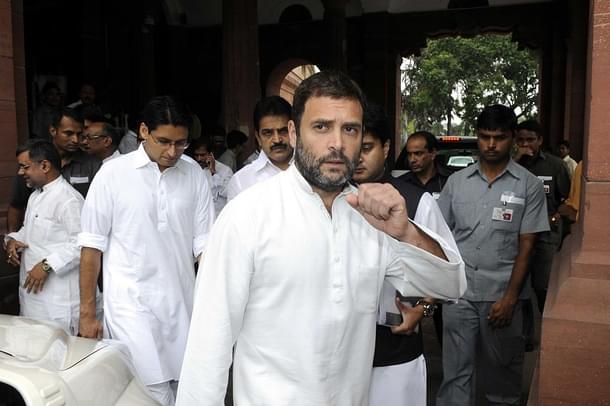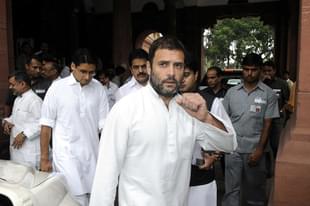Politics
Given Irresponsible Panic-Mongers Like Rahul Gandhi, RBI Should Not Presume Cash Crunch Is Temporary
R Jagannathan
Apr 18, 2018, 02:36 PM | Updated 02:36 PM IST
Save & read from anywhere!
Bookmark stories for easy access on any device or the Swarajya app.


It is more than likely that the cash crunch in some states – Andhra Pradesh, Telangana, Madhya Pradesh, Bihar, and Karnataka, among them – is temporary, driven by a combination of factors like pre-election demand, festival demand, the shift in note printing from higher denomination ones to lower, and a general re-stocking of cash by ordinary people to their old, pre-demonetisation comfort levels.
It is also clear that opposition politicians like Rahul Gandhi will be keen to fan the sense of panic, since this suits their narrative. If more people can be herded towards ATMs in the coming weeks, the cash crunch will become a self-fulfilling prophecy. The Gandhi scion tweeted, rather irresponsibly, that “the country’s ATMs are empty”. The tweet, translated from Hindi, talks of the “deceit” of the note ban, and how the money has gone into “Nirav Modi’s pockets”. Which is a lie. And then, an attempt to create panic: “The terror of noteban has come a second time”
However, it is odd that the government and the Reserve Bank of India (RBI) did not anticipate this crunch when this kind of demand is not a new thing. The problem could lie in the way the central bank estimates demand for cash: apparently it has an econometric model that bases its projections of cash demand based on notes in circulation, notes destroyed, replacement demand, gross domestic product (GDP) growth and inflation, volume of electronic transactions, etc.
Actually, this is the old economy way of estimating demand. In the new economy, where there can be sudden surges of demand or even a collapse for any product, including physical money, the RBI really needs to shift to a big data-based modelling system, assuming it is not already doing so. It has to move to real-time data analysis on currency demand, just as it may be doing to monitor the money markets. The information the RBI needs to manage its cash supplies smoothly needs to be accurate, both in terms of its geographical distribution and in terms of the kinds of notes demanded, and this can’t be done with huge time lags if it works with its old models.
With goods and services tax (GST) data now available almost daily in the GST Network, even the tax authorities need to use big data to estimate revenues, and this data can easily be shared with the RBI.
For any forecast to work in the new economy, where demand for cash can momentarily shift from cash to electronic modes and back to cash, only real-time methods will work.
The second lesson probably relates to the shortage of Rs 2,000 notes. It seems that the reduction in its printing and supply, combined with its hoarding by those who withdrew it earlier, has not been properly compensated. It makes sense to steadily constrict the supply of the Rs 2,000 note, which ultimately needs to be withdrawn in order to disincentivise the use of cash to settle high-value deals. But this measure ought to have been preceded by a flooding of the market with Rs 200 and Rs 100 notes, and bank ATMs ought to have been recalibrated for this purpose.
The Economic Times quotes a State Bank of India deputy managing director as saying that the Rs 2,000 notes dispensed are not coming back to the system. But since the RBI has also reduced its supply, one of the four cassettes used in ATMs often goes empty as Rs 2,000 notes are missing. This means only the remaining three cassettes are replenished – two with Rs 500 notes, and one with Rs 100. By implication, nearly half of every ATM’s cash dispensing capacity (in terms of value) lies unused. It also implies that ATMs have to be replenished faster with smaller notes.
Again, this is the same problem we encountered in November 2016: lack of replacement lower-value currency when higher denomination notes disappeared. The constriction in supplies of the Rs 2,000 note should have been preceded both by recalibrating ATMs for handling more lower value notes, and higher and more frequent supplies of these notes. The slowdown and withdrawal of the Rs 2,000 note should have been stretched over a longer period. Somewhere, this manoeuvre has been mistimed.
The remedy now is to print more Rs 500 notes, speed up ATM recalibration, and deliver even higher volumes of Rs 200 and Rs 100 notes. Ultimately even the Rs 500 note may have to be withdrawn to discourage the use of cash for all but low-value daily transactions.
A third lesson that could have been learnt is the ongoing shift in banks’ digital strategies post-demonetisation. Few banks are now aggressively setting up ATMs and are instead shifting focus to digital currency, including e-wallets, mobile payments, and other forms of electronic payments. A BusinessLine story points out that in the April-August period of 2017, banks added just 93 new ATMs against 4,936 in the same period a year before. Foreign banks, on the other hand, are closing down ATMs.
This data is known to the RBI, but one wonders why with a slowdown in ATM expansion, and an increase in GDP growth rate, it could not have surmised that the current stock of operational ATMs would not be able to handle sudden surges in cash demand.
Two things happen as elections approach: cash demand goes up, and real estate values weaken, since benami properties need to be sold or mortgaged to generate cash for political requirements. Both the direct demand for cash, and the one generated by the need to convert real estate values to cash, should lead to only one conclusion: we are going to see a continued surge all the way to May 2019.
The RBI should button up for one, long dash for cash over the next 12 months. Even if the current shortage is temporary, it should not operate on the assumption that this won’t continue in the foreseeable future.
Jagannathan is former Editorial Director, Swarajya. He tweets at @TheJaggi.





